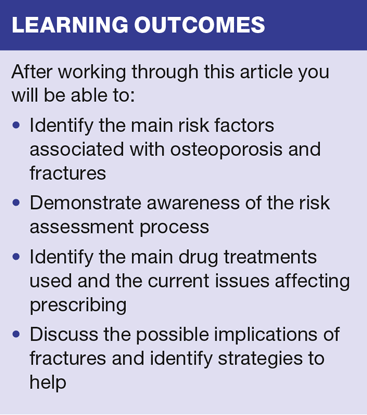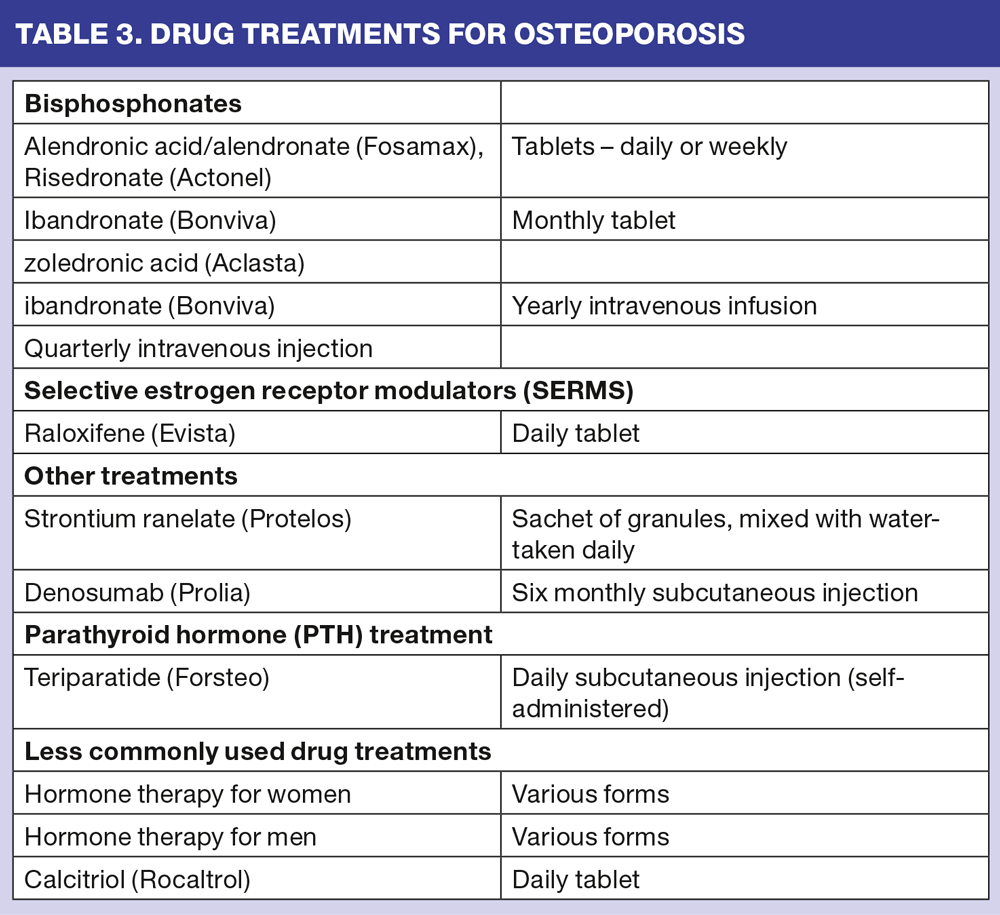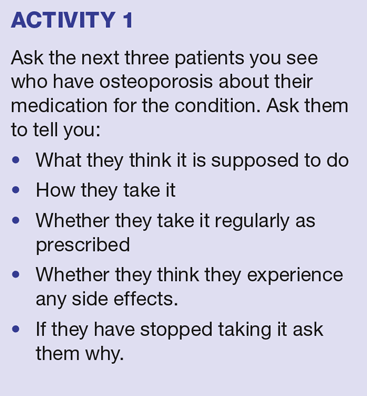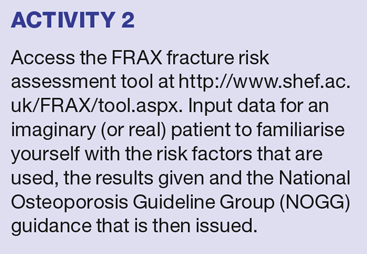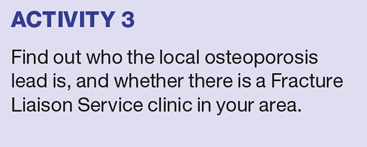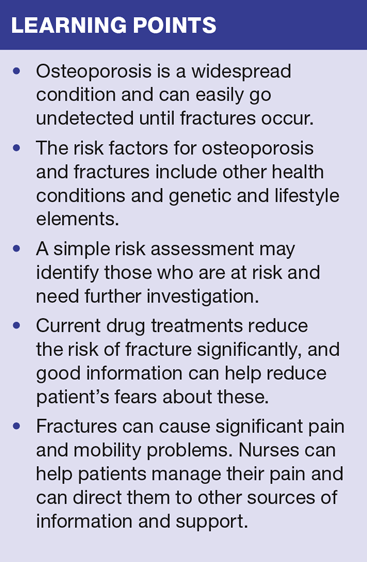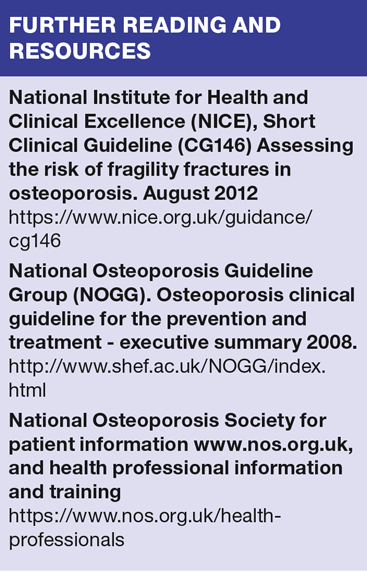Osteoporosis and fractures: diagnosis and management
Kirsty Carne, RGN. Osteoporosis Nurse for the National Osteoporosis Society, Bath UK
Kirsty Carne, RGN. Osteoporosis Nurse for the National Osteoporosis Society, Bath UK
In the UK someone suffers a fragility fracture every 2 minutes. Our ageing population, our greater awareness of the risks associated with osteoporosis and fractures, coupled with increasing pressures on the NHS, means that practice nurses will be involved in the management of many patients with the condition
Bone is living tissue, which constantly remodels through a cycle of turnover, where osteoclast cells remove old bone and new bone is laid down by osteoblasts. After achieving a peak bone mass in our 30s the balance of bone removal and formation alters as we age. Bone mass reaches a plateau in our mid-30s, then steadily reduces as bone resorption becomes more dominant. This leads to increased fragility in the skeleton as micro-architectural deterioration of bone tissue occurs.
Every year people in the UK suffer more than 300,000 fragility fractures – that’s one every 2 minutes.1 With increasing pressures on the NHS, people living longer and a greater awareness of the risks associated with osteoporosis and fractures, it is inevitable that nurses working in primary care will encounter many patients with the condition.
There are a number of risk factors for low bone density and increased fracture risk, including:
- Genetic – risk is increased if either parent broke a hip; age – bone strength decreases with increasing age
- Gender – women have a greater risk than men because their bones are smaller
- Previous fracture(s) – increases risk of subsequent fracture
- Low body weight – BMI <19kg/m2 is associated with higher risk
- Conditions such as coeliac or Crohn’s disease, rheumatoid arthritis.
Low levels of oestrogen in women and testosterone in men are also associated with increased risk of osteoporosis, as are smoking, excessive alcohol consumption, and drug treatments such as corticosteroids (for more than 3 months) and aromatase inhibitors. Both immobility and falls are also linked fragility fractures.
DIAGNOSIS AND RISK ASSESSMENT
Bone density scanning, using dual energy absorptiometry (DXA) scan of the axial skeleton (using the lumbar spine and hip), is considered to be the ‘gold standard’ of diagnostic techniques. There is a high correlation between a low bone mineral density (BMD) and the risk of fractures. The scoring system used for DXA results (table 1) was devised by the World Health Organization in 1994,2 and has since been adopted as a diagnostic and intervention threshold.
While a low BMD measured on a scan is significant in diagnosing osteoporosis and identifying an important risk factor for fracture, this is no longer the only indicator used. For a more targeted approach fracture risk assessment tools such as QFracture and, more commonly, FRAX are now frequently used alongside the DXA results. These allow the healthcare professional to input further simple facts about the patient in order to produce a prediction of their risk of fracture over a given period of time (commonly 10 years) as a percentage. FRAX can be used on people aged 40-90 with or without a BMD measurement. QFracture can be used for people aged 30-84 without a BMD measurement.
The use of these risk assessment tools aids decision making in the prescribing of osteoporosis drug treatments when, for example, a patients’ bone density score may be ‘borderline’, or their age, risk factors or other circumstances suggest that a slightly different approach may be appropriate. From a practice nurse’s perspective these tools are very quick and easy to use in clinic, when you are faced with a patient that you think may be at risk. The results provide a sound basis to flag up further action that may be required, such as a referral for a scan or a discussion with the GP about treatment. People tend to associate osteoporosis mainly with women, but it also affects men. These tools can provide an ideal opportunity to pick up any men in your clinic who may not be aware of their own potential risk.
GUIDELINES
NICE has produced a short clinical guideline ‘Osteoporosis – assessing the risk of fragility fracture’.3 This provides a useful algorithm, guiding health care professionals through fragility fracture assessment for people in different age groups, from 40 upwards. While this helps determine when assessment of a person’s risk of fracture may be pertinent, in terms of scanning and doing a FRAX assessment, it does not provide any thresholds for treatment and refers users to local protocols or other guidelines instead. The Scottish Intercollegiate Guidelines Network (SIGN) has also produced guidelines on the management of osteoporosis.4 These are currently under review.
The National Osteoporosis Guideline Group (NOGG) have proposed treatment thresholds for use with the FRAX 10 year risk prediction.5 The FRAX website (http://www.shef.ac.uk/FRAX/tool.aspx ) gives the option of clicking on the NOGG guidance after the FRAX assessment is completed, which then plots the individual’s result on a graph to determine whether their result falls into either ‘treatment’, or ‘lifestyle advice and reassurance’ categories. A third category of ‘measure BMD’ is also present if a DXA score has not been inserted into the FRAX calculation. This tool can aid risk assessment, although there will be areas that demand good clinic judgement and may require further guidance from the local osteoporosis lead.
NICE has also produced technology appraisals (TAs), both for primary preventive treatment of osteoporotic fragility fractures in postmenopausal women,6 and for secondary prevention of osteoporotic fragility fractures.7 A more recent TA covers the use of a later drug treatment, denosumab (Prolia).8
These TAs guide prescribing of drug treatments based purely on age, BMD measurement and independent, clinical risk factors for fracture, plus, in the case of secondary prevention, the number of fractures that have occurred. They do not include FRAX assessment and NICE has therefore decided to review to improve cohesion between assessment and treatment guidance.
FRACTURE LIAISON SERVICES
Where available, a Fracture Liaison Service (FLS) is another means of identifying a person who has had a fracture and who may be at risk of osteoporosis and further fractures.
The National Osteoporosis Society is currently working with the British Orthopaedic Association and the British Geriatrics Society to produce defined standards to ensure that patients with low trauma fractures are identified, investigated appropriately, and informed about their falls and fracture risk. Those individuals that require any intervention should then receive it, and the sharing of information between secondary and primary care should ensure that long term care and assessment of that individual continues.
TREATMENTS
There is a range of drug treatments for osteoporosis (table 2). All aim to reduce the risk of fractures. Even though the likelihood of a fracture while on one of these drug treatments is significantly reduced (by around 50%), it is still possible to sustain a fracture. Often this is poorly explained to the patient, or poorly understood by them, and they then view a fracture as a sign that their treatment is not working.
With the exception of the human parathyroid treatment, teriparatide (Forsteo), which has an anabolic effect on bone, the drug treatments for osteoporosis are classed as ‘anti resorptive’. This means they act on osteoclasts to try to slow the resorption of ‘old’ bone. This appears to work well and has resulted in the number of treatment options we have today.
The main class of drugs is the bisphosphonates, with generic alendronic acid recommended as first-line treatment.
ADHERENCE
The majority of the oral drug treatments for osteoporosis have very strict administration instructions. With the oral bisphosphonates, this involves taking the drug on waking, with an empty stomach. The tablet must be swallowed whole, with water. No food, drink (except water) or other medications can be taken for at least half an hour afterwards, during which time the patient must remain upright. Patients with swallowing difficulties, mobility issues, or on other morning medications may find these instructions impossible to adhere to. In this case an alternative, such as an injectable treatment, may be more suitable.
Good communication between the patient and their health care team is crucial to ensure that the right drug is prescribed, and that it is taken correctly. Within 12 months of starting drug therapy, approximately 75% of women no longer take it as prescribed, and almost 50% have discontinued it completely.9 Osteoporosis itself causes no symptoms and, similarly, the drug treatments cause no feeling of improvement. Unless this is explained some patients may feel that their drug is not working; they don’t feel any different so they stop taking it.10
TREATMENT CONCERNS AND SCARE STORIES
Taking treatment for osteoporosis appears to be a source of much concern for many patients. Issues surrounding drug treatments are by far the most common reason for people to contact the helpline at the National Osteoporosis Society, and much of this concern is fear of side effects. Whilst many people have concerns over issues relevant to them, such as the suitability of an oral bisphosphonate (which can cause upper gastric irritation) in a person who already suffers with a gastric condition, others have concerns about the very rare, potential issues that are often singled out by the media, forums and social media networks.
Osteonecrosis of the jaw (ONJ) is estimated to affect between one in 10,000 and one in 100,000 people taking bisphosphonates for osteoporosis per year,11 (and with a potentially similar risk relating to denosumab), yet it creates a fear that far outweighs the risk. Atypical femoral fractures (AFF) relating to longer-term exposure to the same treatments, also a rare occurrence, is again a source of greatly heightened concern. The risk of either of these is likely to be many times smaller than the risk of fracture in someone with a high fracture risk who is left untreated, but can still be enough to prompt refusal or cessation of treatment, particularly if these concerns have not been addressed.
The manufacturers of many calcium supplements have amended their guidance on administration to include the possible effect of foods containing phytic or oxalic acid on the absorption of calcium. To the supplement user this appears to rule out a huge number of foods, resulting in much concern, whereas the effect on calcium absorption is potentially minimal. This, coupled with widespread media coverage of some research suggesting a possible link between calcium supplementation and heart disease,12 may result in non-adherence to calcium and vitamin D supplementation. A short conversation may help to resolve these fears. It is also worth remembering that not everyone will need a calcium supplement. NOGG guidance suggests that individuals getting a reliable source of calcium (around 1,000mg per day) from their diet may only need to consider their vitamin D requirements.5
DURATION OF TREATMENT
This is now a ‘hot’ issue. Previously a diagnosis of osteoporosis would have resulted in long term prescription of drug treatment. Awareness of potential risks, such as AFF, associated with long term use has resulted in guidance from NOGG and local protocols suggesting a review at around five years use. This advice is also reiterated in the MHRA guidance.13
Individual assessment, looking at adherence, fractures and other health issues impacting on bone health, may also include a further bone density scan, where necessary. For those whose risk of fracture is currently thought to be lower, a pause in treatment for between 1–3 years may be appropriate. For those whose risk of fracture remains high, treatment needs to be continued. Whether the same treatment is continued (or reinstated after a pause), or an alternative is used will vary according to the individual patient’s circumstances.
FRACTURES
Fractures are the outcome that risk assessment and drug treatments are trying to prevent, and certainly to reduce. Fractures of the wrist, spine and hip are the sites most commonly associated with osteoporosis.
Hip fractures can have an enormous impact, both physically and financially. A month after suffering a hip fracture one in three people will have died and only half will have returned home.14 Vertebral fractures do not cause the same initial impact in terms of financial costs as the majority are not clinically diagnosed and do not require surgical intervention. However, the longer term costs, financial, physical and emotional, is huge due to the potential for long term, chronic pain, reduced mobility, care needs and social isolation.
Pain and symptom management
While some fractures (particularly vertebral) can be painless and remain undetected, others can be a source of acute, followed by long term, chronic pain. While there is no ideal analgesic, because each person has different needs, patients need to be encouraged to discuss it with their prescriber if their current medication seems to be ineffective. A short discussion about what they are taking, when and how can sometimes identify minor changes that might improve its effect.
Good information about what to expect from a pain relieving medication (how long it takes to work, the possible side effects and how best to avoid them) can help increase a patient’s confidence and aid adherence. Exercises to strengthen core muscles, via physiotherapy and, over the longer term, with something like Pilates, can help to improve pain and posture.
For those patients struggling with persistent pain, despite their clinician’s efforts to adjust the analgesia used, a referral to a pain clinic may sometimes be the answer. Although this option can offer an alternative method of pain relief for some patients, for others it can be an opportunity to understand how to accept a level of pain and to learn strategies to plan, prioritise and pace their day, along with good relaxation techniques to enable them to continue with some level of independent life.
Implications of fractures
All fractures can have a big impact on mobility, either temporarily or long term. A fracture may affect a specific limb but postural changes, or pain that limits movement, can result in long term impacts. Referral to a physiotherapist for walking aids, and social services or occupational therapy for aids or adaptations, might be required to improve safety and independence.
Vertebral fractures can be responsible for considerable height loss and kyphosis resulting in associated difficulties including shortness of breath, reduced appetite, changes in bowel and bladder habit.15 These can also have an enormous impact on a person’s self-esteem through an altered body image, and real difficulties in getting clothing to fit. As there is no surgical intervention for most vertebral fractures associated with osteoporosis, it is important to ensure that the patient understands what has happened and its implications; that the compressed vertebrae cannot now change and some management of the problems associated with this may be required.
CONCLUSION
A great deal of osteoporosis management relies on the patient getting good information. Many of the symptoms of fractures go unrecognised and people are frequently left unsupported, despite the distress they are in and the obvious impact on their quality of life. Lack of information and failure to address concerns about drug treatment can result in patients refusing or stopping necessary drug therapy.
There is, however, an enormous amount of information and support out there for people with osteoporosis. The National Osteoporosis Society (NOS) provides a helpline, a website and a huge range of factsheets and leaflets. Practice nurses are ideally placed to help people get the information they need to manage their problems and move forward more positively, whether this is practical help via the surgery or directing them to other sources such as the NOS.
REFERENCES
1. British Orthopaedic Association. The Care of Patients with Fragility Fracture. London: British Orthopaedic Association.2007
2. World Health Organization. Assessment of fracture risk and its application to screening for postmenopausal osteoporosis. Report of a WHO Study Group. Geneva, World Health Organization, 1994 (WHO Technical Report Series, No. 843)
3. National Institute for Health and Care Excellence (NICE). Short Clinical Guideline (CG146) Assessing the risk of fragility fractures in osteoporosis. August 2012 https://www.nice.org.uk/guidance/cg146
4. Scottish Intercollegiate Guidelines Network (SIGN) Management of Osteoporosis. Guideline No 71. June 2003. Updated April 2004. Currently being updated. http://www.sign.ac.uk/guidelines/fulltext/71/
5. National Osteoporosis Guideline Group (NOGG). Osteoporosis clinical guideline for the prevention and treatment. Executive summary 2008, updated 2014. www.shef.ac.uk/NOGG/NOGG_Executive_Summary.pdf
6. NICE. Technology appraisal guidance TA 160. Alendronate, etidronate, risedronate, raloxifene, strontium ranelate and teriparatide for the primary prevention of osteoporotic fragility fractures in postmenopausal women. January 2011. http://www.nice.org.uk/guidance/ta160
7. NICE. Technology appraisal guidance TA 161. Alendronate, etidronate, risedronate, raloxifene, strontium ranelate and teriparatide for the secondary prevention of osteoporotic fragility fractures in postmenopausal women. January 2011. http://www.nice.org.uk/guidance/ta1601
8. NICE. Technology appraisal guidance TA 204.Denosumab for the prevention of osteoporotic fractures in postmenopausal women. October 2010. http://www.nice.org.uk/guidance/ta204
9. Weycker D, Macarios D, Edelsberg J, et al. Compliance with drug therapy for postmenopausal osteoporosis. Osteoporosis International 2006;17:1645–52.
10. Kamatari M, Koto S, Ozawa N, et al. Factors affecting long-term compliance of osteoporotic patients with bisphosphonate treatment and QOL assessment in actual practice: alendronate and risedronate. Journal of Bone and Mineral Metabolism 2007;25(5):302–309.
11. Khosla S, Burr D, Cauley J et al. Bisphosphonate-associated osteonecrosis of the jaw: report of a task force of the American Society for Bone and Mineral Research. Journal of Bone and Mineral Research 2007 Oct;22(10):1479-91.
12. Bolland M J, Grey A, Avenell, A, et al. Calcium supplements with or without vitamin D and risk of cardiovascular events: reanalysis of the Women’s Health Initiative limited access dataset and meta-analysis. BMJ 2011;342:d2040
13. Medicines and Healthcare Products Regulatory Agency. Drug safety update. Bisphosphonates: atypical femoral fractures. June 2011. https://www.gov.uk/drug-safety-update/bisphosphonates-atypical-femoral-fractures
14. National Hip Fracture Database. National Hip Fracture Database (NHFD) extended report 2014. London: Royal College of Physicians.2014
15. National Osteoporosis Society. Life with Osteoporosis: the untold story. 2014 Available at: https://www.nos.org.uk/document.doc?id=1715.
Related articles
View all Articles
